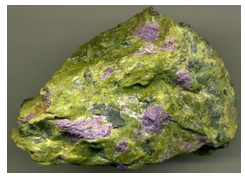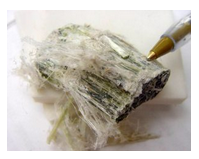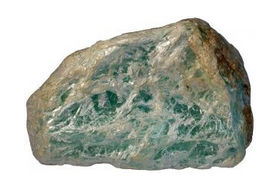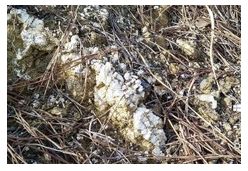8.7.3: Metamorphosed Ultramafic Rocks
- Page ID
- 18629
| Common Minerals in Metamorphosed Ultramafic Rocks | |||
| minerals | |||
|
low grade high grade |
talc Mg3Si4O10(OH)2 c brucite Mg(OH)2 c magnesite MgCO3 c serpentine Mg6Si4O10(OH)8 c olivine (Mg,Fe)2SiO4 c anthophyllite (Mg,Fe)7Si8O22(OH)2 c garnet (pyrope-almandine) (Mg,Fe)3Al2Si3O12 c clinopyroxene (diopside) CaMgSi2O6 c orthopyroxene (enstatite) Mg2Si2O6 |
||
Ultramafic rocks come from Earth’s mantle. Sometimes, during tectonism, they make it to the surface so we can study them. Most of the examples of metamorphosed ultramafic rocks that we see are in ophiolites, slivers of Earth’s oceanic crust and mantle uplifted and accreted onto continents. The outcrop photo below (Figure 8.70) shows a rock of the Lizard Complex, one of the best-known ophiolites.

Mantle rocks are high-temperature, high-pressure rocks that typically contain olivine, clinopyroxene, and orthopyroxene when unweathered. When weathered or metamorphosed at low temperature, the original minerals often react to create low-temperature minerals. Hydration and carbonation reactions occur and produce hydrous and carbonate minerals. Magnesium oxides and hydroxides may also form. Thus, unless metamorphic temperatures are very high, metamorphism of ultramafic rocks produces low-temperature minerals from high-temperature minerals, essentially retrograde metamorphism.
The table above lists the most common minerals in metamorphosed ultramafic rocks. Low-grade minerals are at the top of the table and high-grade minerals at the bottom. Ultramafic rocks are very Mg-rich, and often contain much olivine. Because of their chemistry, Mg-silicates such as talc, serpentine, anthophyllite, diopside, and enstatite are also common in these rocks.

Low-grade metamorphism or alteration of olivine-bearing rocks often produces a brownish, highly weathered, appearance, such as seen in this outcrop photo (Figure 8.71). Typically, these rocks contain serpentine that developed by hydration of olivine. We call rocks rich in serpentine serpentinites. Figure 8.9, near the beginning of this chapter showed another example. Serpentine has three polymorphs: antigorite, lizardite, and chrysotile. The photos below show examples of each.



Antigorite, the most common serpentine mineral that forms during metamorphism of ultramafic rocks, is stable over a wide range of metamorphic conditions. The weathered outcrop in Figure 8.72 is a typical occurrence. The green color and the texture are diagnostic. Lizardite (Figure 8.73), named for occurrences in the Lizard Complex, Cornwall, and chrysotile (Figure 8.74) are less common and form exclusively at low pressures or at Earth’s surface. The green lizardite in the middle photo above contains pinkish inclusions of stichtite, a rare magnesium chrome carbonate. Chrysotile is one of the few recognized asbestos minerals; fine fibers are easily seen in Figure 8.74. The other asbestos minerals are amphiboles.
While serpentine commonly dominates very low-grade ultramafic rocks, several other minerals may also be present. The photos below show talc (hydrated Mg-silicate), brucite (Mg-hydroxide), and magnesite (Mg-carbonate). These minerals, common in metamorphosed ultramafic rocks, can also form in metacarbonates.



At higher metamorphic grades, ultramafic rocks may contain olivine, anthophyllite, enstatite, periclase, or spinel. And, at the highest grades, garnet and pyroxene become stable. Minerals in high-grade ultramafic rocks are the same as the minerals in rocks of the mantle (where pressure and temperature are great). In effect, mantle rocks originated as high-grade metamorphic rocks. We saw photos of several examples in Chapter 6 (Figures 6.118, 6.119, and 6.120).


